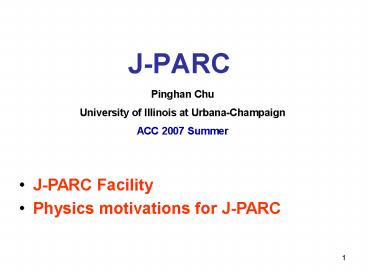JPARC - PowerPoint PPT Presentation
1 / 16
Title: JPARC
1
J-PARC
Pinghan Chu
University of Illinois at Urbana-Champaign ACC
2007 Summer
- J-PARC Facility
- Physics motivations for J-PARC
2
The High Intensity Frontier
- J-PARC aims for the high intensity frontier for
- - materials/life sciences (3GeV)
- - nuclear/particle physics (50GeV)
- High intensity proton beam leads to high
intensity secondary (neutron, kaon, muon,
neutrino) beam.
3
J-PARC Facility
J-PARC Japan Proton Accelerator Research Complex
Joint Project between KEK and JAEA
4
Location of J-PARC at Tokai
295 km
JAEA
Tokai
1 hour
Tsukuba
5
Phase 1 and Phase 2
6
Beam Performance
- Beam Energy 50 GeV
- Linac Energy 400 MeV
- Repetition 3.45-6 Sec
- Flat Top Width 0.72-3 Sec
- Beam Intensity 3.3x1014ppp, 16uA
- Beam Power 750 kW
7
Goals of J-PARC
High intensity proton beam leads to high
intensity secondary (neutron, kaon, muon,
neutrino) beam.
Radioactive Nuclei
8
3. ?????????
Materials and Life Experimental Facility
9
Materials Life Experimental Facility
Neutron Scattering Area
Muon Experimental Area
Proton Beam
10
295 km West
Super Kamiokande
Neutrino Experimental Facility
11
T2K Experiment
Intense neutrino beam by 100 times at KEK 12 GeV
PS
T2K Tokai to Kamioka
Muon neutrino beam
J-PARC
(Tokai)
(Kamioka)
12
From K2K to T2K
Data since 1999
K2K KEK to Kamioka
Without oscillation
With oscillation
107 events observed (151 events expected without
any oscillations) ? 99.99 confident that n
carries a finite mass.
Best fit
13
Hadron Experimental Facility
14
Hadron Experimental Hall (Phase 1)
Experimental Area
Test Beam
A-Line
Beam Dump
(on the guide rail for Phase 2)
15
Beamline
- K1.8 beamline High quality kano beamline (1.8
GeV/c), for hypernuclear study, especially of
S-2 systems, using (p,K),(K,p),and (K,K)
reactions. - K1.1/K0.8 beamline High quality kaon beamline
with lower momenta. Suitable for stopped kaon
experiments as well as K decay experiments, etc. - K0 beamline Specifically designed for
16
Summary
- J-PARC will be the highest intensity accelerator
complex of the GeV and ten-GeV energy regions in
the world. - The major aims are materials/life sciences by
RCS(3GeV), nuclear and particle physics by MR (50
GeV) and RD for nuclear transmutation technology
by Linac (600 MeV). - This is a wide variety of physics possibilities,
including hadron physics -- Drell-Yan and
quarkonium production, vector mesons, neutrino
beam, etc.































